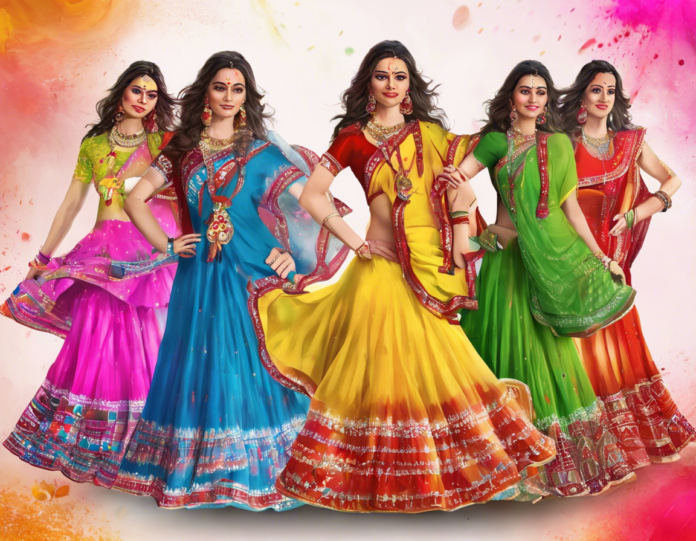Navratri, a vibrant and auspicious Hindu festival celebrated with zeal and devotion across India, is marked by nine days of fasting, prayers, and festivities. Each day is dedicated to a different form of Goddess Durga, and devotees adorn themselves in specific colors that are believed to resonate with the energy of that particular day. These Navratri colors hold significance and are chosen accordingly to invoke blessings and bring harmony to various aspects of life. In this article, we will delve into the Ultimate Guide to Navratri Colours 2022 and explore the significance of each color to help you celebrate the festival with the right hues and positive vibes.
Day 1: Pratipada – Grey
On the first day of Navratri, devotees wear grey, symbolizing the calmness and composure needed to start the journey of this nine-day festival.
Day 2: Dwitiya – Orange
Orange signifies energy and happiness, bringing a sense of vitality and enthusiasm, perfect for the second day of Navratri.
Day 3: Tritiya – White
White represents purity and peace, essential for seeking blessings and embracing spirituality on the third day of Navratri.
Day 4: Chaturthi – Red
Wearing red on the fourth day symbolizes strength and power, invoking the Goddess Durga’s fierce form to combat any obstacles.
Day 5: Panchami – Royal Blue
Royal blue conveys loyalty and intelligence, bestowing devotees with wisdom and clarity on the fifth day of Navratri.
Day 6: Sashti – Yellow
Yellow signifies prosperity and joy, illuminating the sixth day of Navratri with brightness and positive energy.
Day 7: Saptami – Green
Green represents nature and fertility, fostering growth and harmony on the seventh day of Navratri.
Day 8: Ashtami – Peacock Green
Peacock green symbolizes elegance and beauty, invoking grace and blessings on the eighth day of Navratri.
Day 9: Navami – Purple
On the final day of Navratri, purple is worn to embody luxury and sophistication, inviting abundance and prosperity.
Significance of Navratri Colors
- Spiritual Connection: Each color corresponds to a specific energy that aligns with the qualities of the Goddess being worshipped.
- Symbolism: The colors hold symbolic significance and help devotees focus on embodying those traits during the festival.
- Harmony and Balance: Wearing the designated Navratri colors is believed to bring balance and harmony to life by attracting positive energies.
- Unity in Diversity: Despite the diversity of colors, Navratri colors unite devotees in celebrating the festival with shared beliefs and traditions.
Tips for Choosing Navratri Colors
- Plan Ahead: Prepare your outfits in advance to ensure you have the right color for each day of Navratri.
- Accessories: Incorporate accessories like bangles, scarves, or jewelry in the designated color if you don’t have suitable attire.
- Mix and Match: Be creative and mix different shades of the assigned color to create unique and stylish ensembles.
- Personal Touch: Add a personal touch by combining the Navratri color with your personal style to stand out while respecting traditions.
FAQs (Frequently Asked Questions)
1. Can I wear different shades of the designated Navratri colors?
Yes, you can wear varying shades of the Navratri colors to showcase your creativity and style while still adhering to the tradition.
2. What if I don’t have the exact Navratri color for a particular day?
If you don’t have the exact color, you can opt for the nearest shade or accessorize with elements in the designated color to align with the tradition.
3. Are there any specific rituals associated with wearing Navratri colors?
While there are no specific rituals, wearing the Navratri colors is considered auspicious and is believed to bring blessings and prosperity during the festival.
4. Can men also follow the tradition of wearing Navratri colors?
Yes, men can also participate in the tradition of wearing Navratri colors by incorporating the designated hues in their outfits or accessories.
5. How can I incorporate Navratri colors in my daily attire without buying new clothes?
You can use scarves, dupattas, stoles, jewelry, or even subtle makeup in the designated Navratri colors to adhere to the tradition without purchasing new clothing.
6. Is there any specific significance of the order of Navratri colors?
The sequence of Navratri colors is believed to align with the energy flow of the festival, starting with calmness and ending with prosperity and luxury.
7. What should I do with the outfits worn during Navratri after the festival is over?
After Navratri, you can continue to wear the outfits in daily life or choose to donate them as a symbolic gesture of spreading positivity and blessings.
8. Are there any regional variations in the Navratri colors followed across India?
Yes, there might be slight regional variations in the choice of Navratri colors, but the essence of invoking blessings and celebrating the festival remains consistent.
Wrapping Up
Navratri colors play a significant role in enhancing the spiritual connection and festive ambiance during the nine-day celebration of this auspicious festival. By understanding the symbolism and significance of each color, devotees can embrace the energy of Goddess Durga’s various forms and invoke blessings associated with each day. Remember to plan your outfits, mix and match colors creatively, and incorporate accessories to adhere to the tradition while expressing your personal style. May the Navratri colors bring prosperity, happiness, and harmony into your life as you revel in the festive spirit of this joyous occasion.
